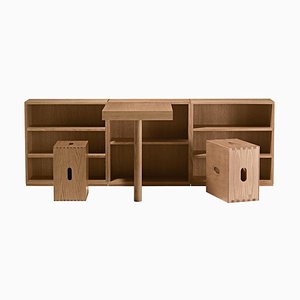
Born in Switzerland in 1887 as Charles-Édouard Jeanneret, Le Corbusier was an architect, urban planner, painter, writer, designer, and theorist who lived and worked primarily in France. In 1900, he began to study at the École d'Art in La Chaux-de-Fonds, Switzerland, as an engraver and goldsmith, expanding his studies in 1904 to include architecture. Among his influential early teachers were Auguste Perret, Jose Hoffman, and architect Peter Behrens. During World War I, Le Corbusier taught at his old school in La Chaux-de-Fonds. After the war, he returned to Paris and worked on concrete structures for the government while focusing most of his energy on painting.
In 1919, Le Corbusier and painter Amédée Ozenfant—cofounders of the Purism movement—launched the art magazine L’Esprit Nouveau (the Le Corbusier pseudonym was officially adopted in its first issue). The magazine presented Le Corbusier’s ideas on modern architecture, which were based on a philosophy of harmony and proportion. In 1922, he and his cousin Pierre Jeanneret opened a studio in Paris, a partnership that lasted until 1940. The pair began to experiment with furniture design after architect Charlotte Perriand joined the studio in 1928. In his design, architecture, and artwork, Le Corbusier embraced elemental geometric forms. In 1943, he developed Modulor, a system of proportions based on the male figure and the golden ratio, which was used to determine the proportions of units in architecture and technology. This also served as the basis for his furniture design.
After World War II, Le Corbusier sought efficient ways to house large numbers of people in response to the housing crisis. His most notable housing unit was the Unité d'Habitation of Marseilles (1946–52). He was also a founding member of the Congrès International d'Architecture Moderne (CIAM). During the 1950s, he was presented the unique opportunity to translate his vision on a large scale with the construction of the newly founded capital city of Chandigarh, India.
A leading 20th-century modern architect, Le Corbusier pioneered the International style, working primarily with steel and reinforced concrete. His buildings were constructed across central Europe, India, and Russia, and one each in North and South America. Arguably, his most notable works are the Weissenhof Settlement in Stuttgart (1927) and Villa Savoye (1929–31). In 1961, he was awarded the Frank P. Brown Medal and the AIA Gold Medal. In 1964, Milan’s Cassina S.p.A. acquired exclusive worldwide rights to manufacture his furniture designs.
Le Corbusier died in August 1965.


